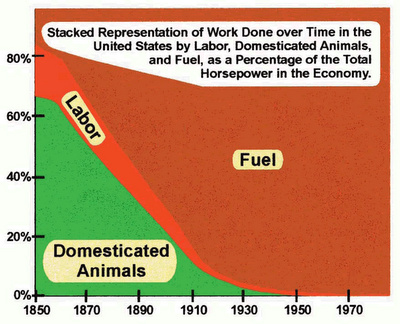I came across this graphic on Keith Johnson’s Permaculture And Regenerative Design News blog. Keith used it to support the idea that the production systems that sustain major urban areas lie far the urban boundary. The term we use for this is displaced impact, and we’ve written about how it applies to minimum impact camping. It’s an important concept and one that a thinking person should be familiar with. But today’s post deals with something else that’s visible in the graphic; outdoor living is hard work.

A quick look at the graphic tells you that over 90% of work has been done in this country by fuel since at least 1930. We travel by car or outboard motor, dig with a back hoe, cut wood with a chain saw, etc. Bushcraft, or living a simple outdoor life, is the opposite. When you’re in the middle of nowhere with little or no infrastructure or motors, you are the engine that accomplishes things, not fuel or domestic animals. I’m not trying to say I don’t use modern conveniences or that they’re bad, but I am trying to point out that if you’re planning a long wilderness trip your body will be working harder than you do at home and you should be prepared for it. People on trips and courses are often shocked at how tired they are at the end of the day, but if you take into account all that they physically accomplished during that day it becomes obvious. They’re tired because their labor, instead of being an infinitesimal percentage of the work they accomplished, jumped to near 100%.







